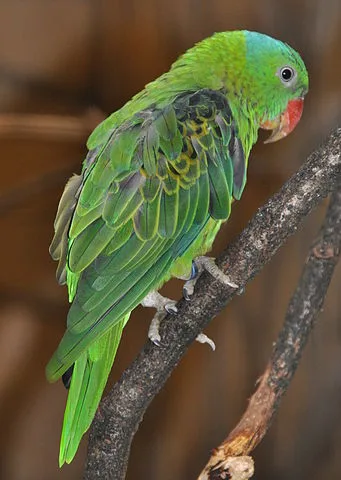
Blue-naped Parrot
[order] PSITTACIFORMES | [family] Psittacidae | [latin] Tanygnathus lucionensis | [authority] Linnaeus, 1766 | [UK] Blue-naped Parrot | [FR] Perruche a nuque bleu | [DE] Blaunacken-Papagei | [ES] Loro Nuquiazul | [NL] Blauwnekpapegaai | [copyright picture] Quartl
Subspecies
| Genus | Species | subspecies | Region | Range |
| Tanygnathus | lucionensis | OR | Philippines | |
| Tanygnathus | lucionensis | hybridus | Polillo (n Philippines) | |
| Tanygnathus | lucionensis | lucionensis | Luzon and Mindoro (n Philippines) | |
| Tanygnathus | lucionensis | salvadorii | c Philippines to ne Borneo Is. | |
| Tanygnathus | lucionensis | talautensis | Talaud Is. (n Moluccas) |
Genus
The Tanygnathus genus is a group of a parrots native to the Indonesia Islands. This genus includes the great-billed parrot, the blue-naped parrot, the blue-backed parrot and the black-lored parrot. Members of the genus Tanygnathus, like most parrot genera, fly fairly fast, and the habitat of the genus is dense evergreen montane forest.
Physical charateristics
Medium to large sized green parrot with large red bill. T.l. lucionensis: both adults-back of crown to back of head blue; median wing coverts margined yellow/orange; back washed with blue. Eye yellow. T.l. hybridus: both adults-as in lucionensis, but back of crown green and back of head paler blue tinged with violet. T.l. talautensis (includes salvadorii): both adults-as in lucionensis but back without blue.
Listen to the sound of Blue-naped Parrot
[audio:https://planetofbirds.com/MASTER/PSITTACIFORMES/Psittacidae/sounds/Blue-naped Parrot.mp3]
Copyright remark: Most sounds derived from xeno-canto
recorded by Desmond Allen
| wingspan min.: | 0 | cm | wingspan max.: | 0 | cm |
| size min.: | 31 | cm | size max.: | 33 | cm |
| incubation min.: | 0 | days | incubation max.: | 0 | days |
| fledging min.: | 0 | days | fledging max.: | 0 | days |
| broods: | 1 | eggs min.: | 2 | ||
| eggs max.: | 3 |
Range
Oriental Region : Philippines. Tanygnathus lucionensis is confined to the Philippines, where there are records from at least 45 islands, plus the Talaud Islands, Indonesia, and islands off north-east Borneo belonging to Malaysia.
Habitat
It is a bird of closed and open forest formations, including second growth, coconut plantations, banana patches and mangrove, chiefly in lowland and coastal areas, up to 1,000 m. It is usually found in flocks of up to 12 individuals which roost communally and make regular dawn and dusk flights between feeding and roosting areas.
Reproduction
Nests in tree cavities natural or old woodpecker nests, often found in a clearing. Clutch size is 2-3 eggs in captivity.
Feeding habits
It feeds in fruiting trees on nuts, fruits, berries and also on grain in other habitats. Nesting takes place in a hole in a tree in April-Juneq
Video Blue-naped Parrot
httpv://www.youtube.com/watch?v=UtA-Fs39_wk
copyright: Martin Kennewell
Conservation
This species is listed as Near Threatened because there are some indications that it has a moderately small, fragmented population, and it may be undergoing a continuing decline owing to trapping and forest loss. However, little is currently known about the population size and structure of, and threats to, this species. Further information is needed to improve the accuracy of this assessment.
It has declined through trapping (for both domestic and international trade) and habitat loss owing to agricultural expansion and logging pressure. It was common on most islands in the Philippines a century or less ago, but has suffered declines since on such a scale that it is now rare or extinct on many islands. However, while not a small-island specialist it does survive in small pockets of habitat on the smaller islands, so that its status overall is difficult to assess. Moreover, it is still fairly numerous in some areas of Palawan and on Tawitawi, and high numbers persist in a large tract of forest on Talaud. The total population was provisionally estimated to be below 10,000 individuals in 1993
It has declined through trapping (for both domestic and international trade) and habitat loss owing to agricultural expansion and logging pressure. It was common on most islands in the Philippines a century or less ago, but has suffered declines since on such a scale that it is now rare or extinct on many islands. However, while not a small-island specialist it does survive in small pockets of habitat on the smaller islands, so that its status overall is difficult to assess. Moreover, it is still fairly numerous in some areas of Palawan and on Tawitawi, and high numbers persist in a large tract of forest on Talaud. The total population was provisionally estimated to be below 10,000 individuals in 1993

Migration
Resident on small islands, some movements my occur on larger landbodies.
Distribution map

